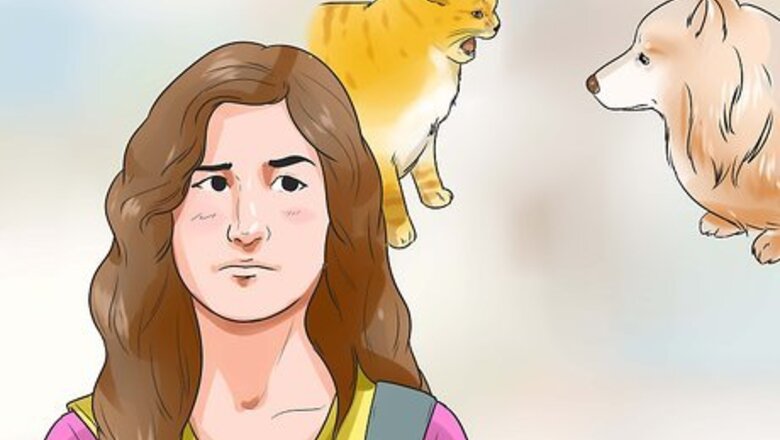
views
Planning Ahead

Be realistic. Some animals will just never get along. If you already have a dog, think carefully before introducing a cat to your house. No matter how badly you may want a new furry friend, it is unfair to both animals to make such a big change without knowing how it could affect their quality of life. The American Humane Society suggests that a dog that becomes aggressive in the presence of a calm, still cat, or utterly loses her ability to concentrate on anything else, will probably never be able to live peacefully with a cat. Cats and dogs will get along better if they're raised together.

Don’t hesitate to seek help. This is a difficult, sometimes impossible behavior to train, and if you are relatively inexperienced you may be in over your head. There are many professional dog trainers who can help assess your dog’s limits, and work with you to develop a more detailed strategy.

Keep your expectations reasonable. This will likely be a slow process. Do not expect too much too soon, and do not be surprised if your animals exhibit animosity or fear.

Start young. Puppies and kittens that grow up together have the best chance of getting along as adults. If your dog is already fully grown, consider getting a kitten instead of a cat. A kitten is less likely to be afraid of a dog, or to trigger your dog’s chase instincts by scampering.

Do a test run. If you know someone who has a particularly even-tempered cat, or one that is already used to dogs, ask if you can bring your dog over for a controlled test. This will give you an idea of how difficult it will be to get your dog used to living with a cat.

Build up to it. If you are certain you want to bring a cat into your home, start by bringing in things that smell like the cat—grooming supplies, beds, etc. Bring things like baby gates, litter boxes, food bowls, and scratching posts into your house before the cat, to give your dog time to get used to these objects.
Training Your Dog Ahead of Time
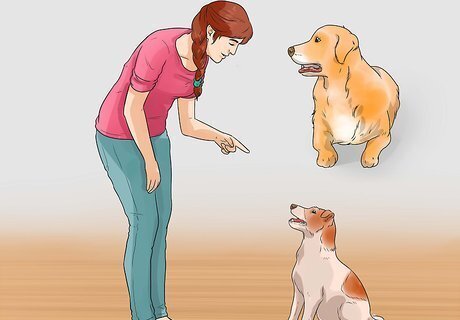
Master the basics. Learning to get along with cats is a high bar for many dogs to clear; they are simply hard-wired to chase small, furry things. If your dog is poorly trained this process will the doomed from the start. At a minimum your dog should reliably obey commands to sit, stay, lie down, heel, and come when called. If he or she does not, it is strongly advised that you Teach Your Dog Basic Commands before you continue.

Have a reward marker. If you have ever watched a professional dog trainer at work, you have probably seen them use a clicker. The sound a clicker makes is called a reward marker. It tells your dog, “what you just did was great, and you’re going to get a treat for it!” This ensures that she understands exactly what behavior she is being rewarded for. You can use the word “yes” (or another word of your choosing) if you prefer, but a clicker is the most effective tool, because it is a sound your dog is unlikely hear in any other context. This is relatively simple to teach, and if you follow the instructions in the article Clicker Train Your Dog, your dog should figure it out pretty quickly.
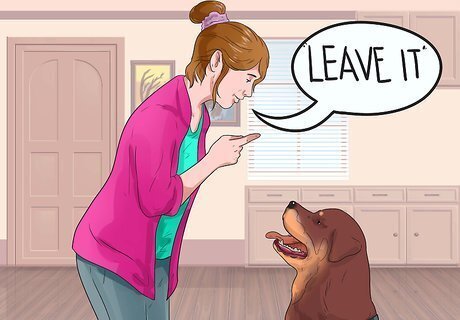
Teach your dog the command “leave it.” This behavior is trickier to teach than those mentioned above, and many dog-owners neglect it. It is one of the most useful tools you can have in your obedience arsenal, however. It will enable you to stop your dog from engaging in dangerous, destructive, or generally unwanted behavior, and will be invaluable in teaching him or her to interact safely with a cat. As with any behavior, you will need to start simple, then gradually introduce elements of difficulty as your dog masters the basic concept.
Getting Your Dog Used to Being Around a Cat

Start in a neutral outdoor area. Your dog thinks of your home as her territory, and may feel threatened and defensive if a new animal is suddenly brought in. It can be helpful to begin outside, with the cat in a pen and your dog on a leash. Start at a distance and gradually approach the pen with your dog. When you get close enough that she notices the cat, stop. Let your dog look at the cat for a few seconds, then say your dog’s name. When she looks at you, click and treat. Repeat this process—let her look at the cat, say her name, and reward her when she looks at you. The idea is for her to associate remaining calm at the sight of the cat with being rewarded. If your dog is too distracted by the sight of the cat to focus, move away from the cat until your dog will reliably look at you every time you say her name. Gradually move closer to the pen, continuing this process as you go. Make sure you give your dog plenty of treats; it’s important that you make good behavior more rewarding than bad behavior. Keep practicing until your dog can do this while standing right next to the cat’s pen. Be patient. The amount of time you will need to spend on this will vary depending on your dog.
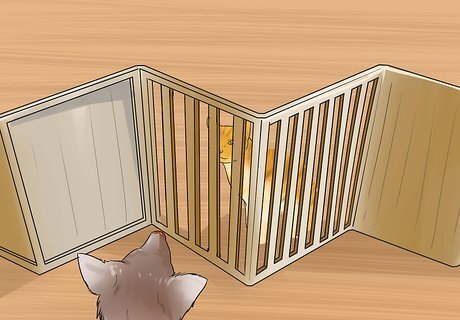
Make the introduction in your home, using a baby gate to keep the two in separate rooms. This is a good option if you are unable to have them meet in a neutral area, or if your cat is distressed by being in a pen outside. Get the cat set up in a designated room of the house that the dog does not have access to. Put his bed, water and food bowls, scratching post, liter box, and toys in this room. The idea is to create a space that feels safe to him. Give him at least a couple days to acclimate before you begin introducing the dog. Put your dog on a leash and fill your pockets with her favorite treats, as well as a couple treats for your cat. The door to the cat’s room should be open, but blocked by a baby gate. For the first couple days, just practice walking past the door with your dog. Click and treat for a calm demeanor, and throw your cat a treat as well to help it associate the dog’s presence with good things happening. Practice basic obedience with your dog in proximity to the cat. You want your dog to become used to keeping her focus on you even in the cat’s presence, and your cat to see your dog as non-threatening. If your dog is too distracted to focus on you, move further away from the cat until you have her attention. Move gradually closer as she gets used to this activity.

Use a crate to keep the two separate during their introduction. Only use this option if your dog is crate-trained—if she does not have positive associations with being crated, she will probably become too worked up to learn effectively. Have your dog go into her crate and shut the door. Bring the cat into the room. Your dog may start whining, yipping, pawing at the door, or even growling. Let her react in whatever way is natural to her. Again, let the cat set the pace of this interaction. If he does not want to approach the crate, do not force him. Click and treat for moments of silence or calmness from your dog. Let them do what they want for 10 or 15 minutes, and then separate them. Continue these training sessions until your dog remains calm in the cat’s presence. At this point, proceed following the steps described above.
Moving Forward

Let the cat set the pace. When he is comfortable enough to become curious, he will approach the baby gate to investigate when you walk by with your dog. If both animals seem calm and curious when interacting through the gate, you are ready to try having them in the same room.

Keep your dog on a loose leash, but be ready to react if she tries to chase the cat. This would be an appropriate time to use the command “leave it.” If your dog begins whining or getting agitated and excited, remove the cat to its room and practice basic obedience with your dog until she calms down.

Continue this practice for a few weeks. Do not attempt letting your dog interact with your cat off-leash until you are absolutely confident that she will not become aggressive or chase the cat. This will undo a huge amount of the progress you have made.

When you feel absolutely confident, take your dog off the leash. Continue to keep a close eye on both animals. Be sure to click and reward your dog for any positive behavior.
Helping Dogs and Cats Who Live Together Get Along
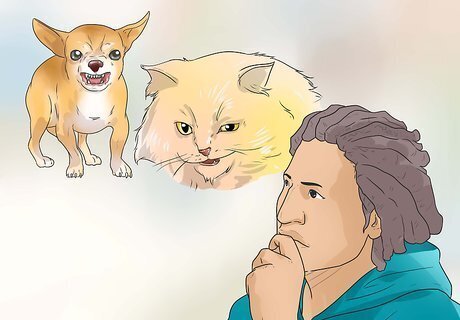
Have realistic expectations. No matter how badly you want your dog and cat to love each other, you may never get them to do anything but tolerate each other. If they are already at odds, even that may not be realistic. First impressions are crucial to helping a dog and a cat live together in harmony, and once they’ve taken a dislike to each other it is very hard to reverse the relationship. Some of the methods described above could be used with animals already living in the same home, but it is important to remember that you cannot change an animal’s nature, and you cannot force two animals to be friends any more than you can force two humans.

Prevent your dog from chasing your cat. This is the most important facet of keeping the peace between dogs and cats. Allowing your dog to discover how fun it is to chase cats will give her positive reinforcement for behavior you do not want, and make her much more difficult to train. It will also make your cat see your dog as a thing to be feared. Be firm and consistent, and make sure your dog obeys “leave it” without hesitation.

Supervise all interactions. Until you are positive beyond a shadow of a doubt that they can be trusted, never leave a cat and a dog alone together. An altercation between them while you are gone could undo all the progress you have made. Always err on the side of caution if you are not 100% certain.

Respect your pets’ boundaries. Forcing them to interact will only cause your animals to associate being around each other with unpleasant feelings, and make them more likely to lash out.
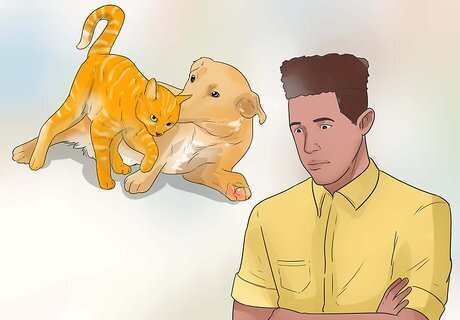
Stay calm. If you are tense and on-edge, your animals will sense it, and it will make them nervous as well. Keep cool, and if you, your dog, or your cat become upset, separate your animals and come back to training when you are all calm.
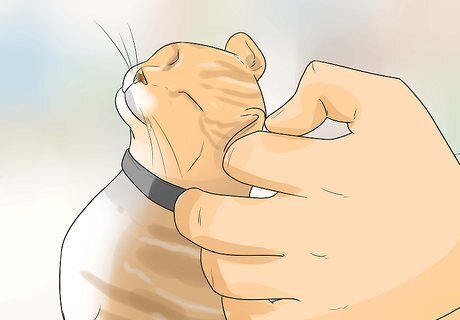
Make sure the cat never feels trapped. A cat doesn’t understand the concept of a leash, and keeping your dog restrained will not necessarily make the cat feel any more at ease. An animal that feels trapped is a desperate animal, and if the cat does not feel he can get away to a dog-free area, he may lash out or flee. Give your cat its own space where the dog can't access it.




















Comments
0 comment